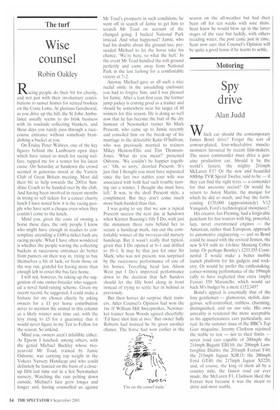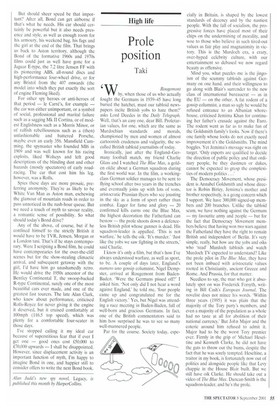Spy drive
Alan Judd
Which car should the contemporary James Bond drive? Forget the sort of armour-plated, four-wheel-drive musclemonsters favoured by recent film-makers, The suave commander must drive a genuine production car. Should it he the world's fastest, the mighty 24 I mph McLaren Fl? Or the new and beautiful 800bhp TVR Speed Twelve, said to be — if they can find the right tyres — a contender for that awesome record? Or would he return to Aston Martin, the marque for which he did so much, and buy the forthcoming £170,000 (approximately) V12 Vanquish, Ford's technological showpiece?
His creator, Ian Fleming, had a forgivable penchant for fast tourers with big, powerful, lazy, never overstressed engines — the American, rather than European, approach to automotive engineering — and so Bond could be issued with the revived Jensen, the new S-V8 with its 4.6-litre Mustang Cobra lump. Or perhaps Bentley's £233,355 Continental T would make a better mobile launch platform for his gadgets and rocketry. Or would he prefer the rattlesnaking, corner-winning performance of the 199mph (silly to have neglected that extra 1mph) Ferrari 550 Maranello, which would set back M's budget by a mere £152,345?
Bond's appeal is essentially that of the foxy gentleman — glamorous, stylish, dangerous, self-controlled, ruthless, charming, distinguished, and on our side. His own unreality is rendered the more acceptable as his appurtenances, cars particularly, are real. In the summer issue of the BBC's Top Gear magazine, Jeremy Clarkson rejoined
the stable to test — not to their limits seven road cars capable of 200rriph: the 214mph Bugatti EB110; the 208mph Lamborghini Diablo; the 201mph Ferrari F40; the 215mph Jaguar XJR15; the 200mph Ford GT40; the 217mph Jaguar XJ220; and, of course, the king of them all by a country mile, the fastest road car ever made, the McLaren Fl. Clarkson liked the Ferrari best because it was the nicest to drive and most usable. But should sheer speed be that important? After all, Bond can get airborne if that's what he needs. His car should certainly be powerful but it also needs presence and style, as well as enough room for his armoury, his weekend bag, his fags and the girl at the end of the film. That brings us back to Aston territory, although the Bond of the formative 1960s and 1970s films could just as well have gone for a Jaguar E-type, the 7.2 litre Jensen FF with its pioneering ABS, all-round discs and high-performance four-wheel drive, or for any Bristol from the 407 onwards (the model into which they put exactly the sort of engine Fleming liked).
For other spy heroes or anti-heroes of that period — le Cane's, for example — the car was either unimportant, or a symbol of social, professional and marital failure such as a sagging Mk II Cortina, or of modest Englishness such as a Morris Minor, or of raffish rebelliousness such as a (then) unfashionable and battered Porsche, maybe even an early 356. Mansfield Cumming, the spymaster who founded MI6 in 1909 and was well known for his racing exploits, liked Wolseys and left good descriptions of the blinding dust and other hazards (mostly spectators) of early roadracing. The car that cost him his leg, however, was a Rolls.
Spies these days are more prosaic, preferring anonymity. They're as likely to be White Van Man as Aston man, eschewing the glamour of mountain roads in order to pass unnoticed in the rush-hour queue. But we need a touch of myth to savour reality, a romantic sense of possibility. So what should today's Bond drive?
Any of the above, of course, but if he confined himself to the strictly British it would have to be TVR, Jensen, Morgan or a London taxi. That's if he stays contemporary. Were I scripting a Bond film, he could have contemporaries for the over-the-cliff scenes but for the show-stealing climactic arrival, and subsequent getaway with the girl, I'd have him go unashamedly retro. He would drive the 1950s ancestor of the Bentley Continental T, the swoop-backed R-type Continental, surely one of the most beautiful cars ever made, and one of the greatest fast tourers. The late Alan Clark, who knew about performance, criticised Rolls-Royce for never giving it the engine it deserved, but it cruised comfortably at 100mph (116.5 top speed), which was plenty for a comfortable four-seater in those days.
I've stopped calling it my ideal car because of superstitious fear that if ever I get one — good ones cost £50,000 to 00,000 upwards — I shall be disappointed. However, since displacement activity is an important function of myth, I'm happy to imagine Bond in one, and happier still to consider offers to write the next Bond book.
Alan Judd's new spy novel, Legacy, is published this month by HarperCollins.



































































 Previous page
Previous page